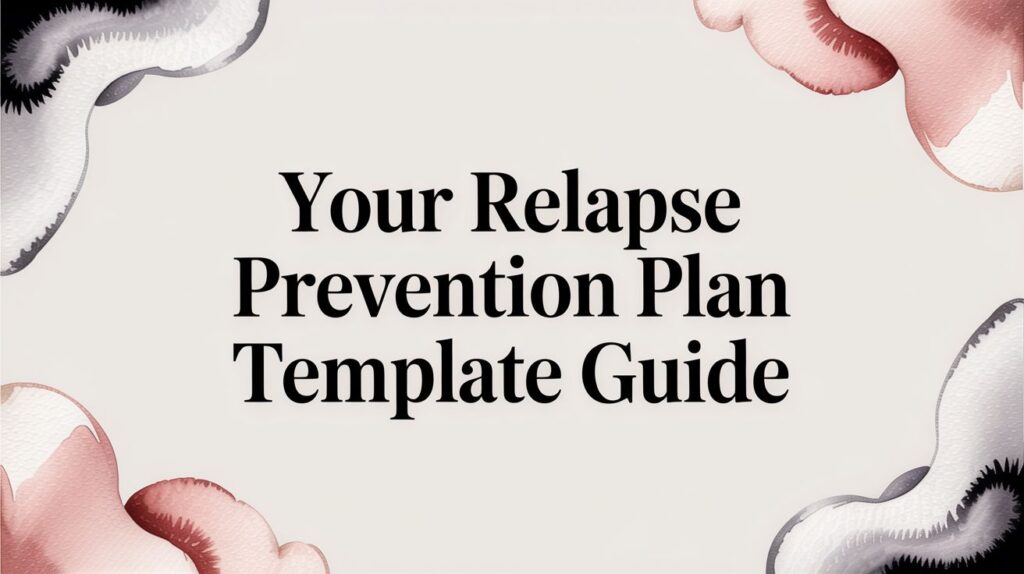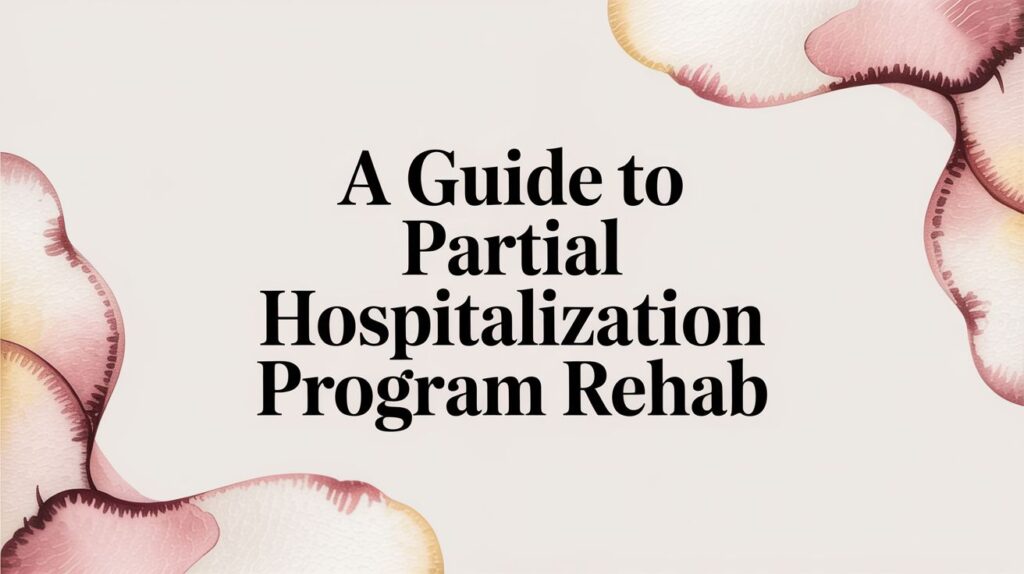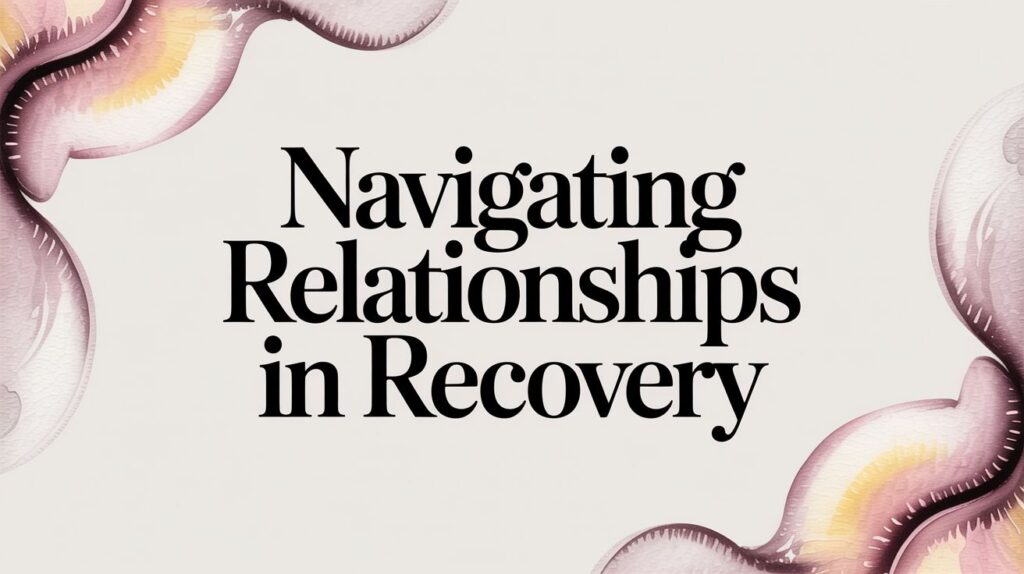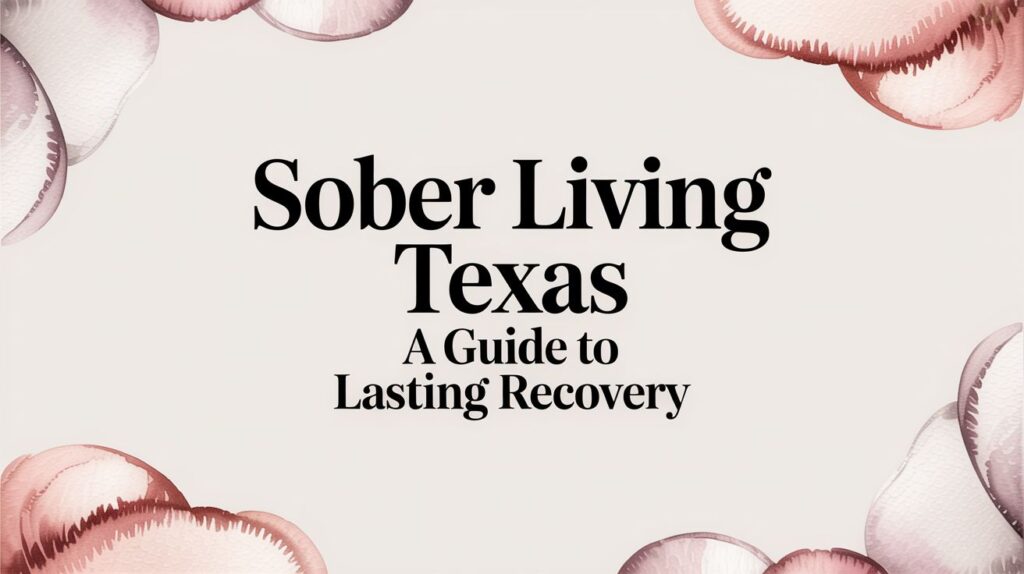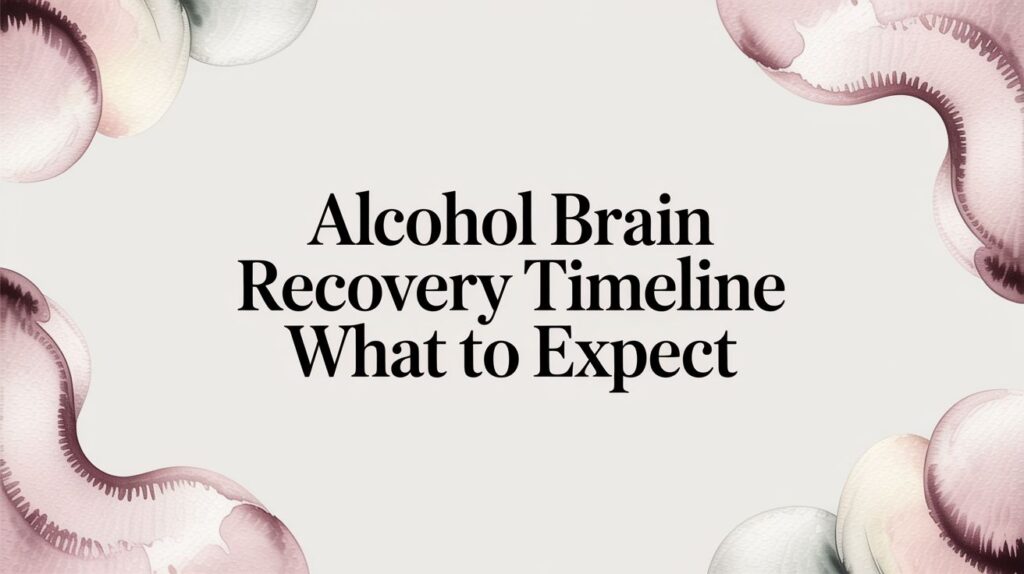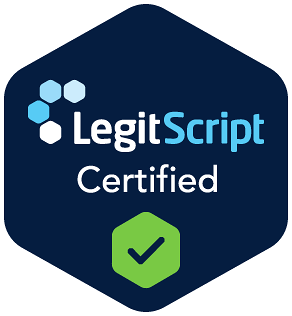A relapse prevention plan is your personal roadmap for navigating recovery. Think of it as a proactive strategy you create before a crisis hits, outlining your unique triggers, go-to coping skills, and the support system you'll lean on to maintain your sobriety.
This guide gives you the template and step-by-step instructions to build a plan that truly empowers you on your journey.
Building Your Foundation for Lasting Recovery
Recovery is an ongoing journey, not a one-and-done destination. Shifting to this mindset takes the pressure off. It reframes challenges not as failures, but as opportunities to learn and get stronger.
A relapse prevention plan is one of the most powerful tools you can have for this journey. It acts as a personalized guide to help you navigate the inevitable ups and downs of life without returning to old habits. It’s all about building resilience, not just trying to avoid temptation.
The process itself puts you back in the driver's seat of your own sobriety. Instead of reacting when things get tough, you'll have a clear, logical set of actions to follow—a tangible document that cuts through the noise when emotions or cravings might otherwise cloud your judgment.
Why a Proactive Plan Is Essential
Let's be honest: just hoping for the best after treatment isn't a strategy. The statistics really drive home how important it is to be prepared. Historical reviews of alcoholism outcome studies have found that more than 75% of individuals relapsed within one year of treatment, which highlights just how chronic addiction can be.
A relapse prevention plan transforms abstract recovery goals into concrete, actionable steps. It’s your playbook for high-risk situations, ensuring you have a plan before you're in the heat of the moment.
This isn’t just about making a list of phone numbers. It’s a deep dive into self-awareness, requiring you to get brutally honest about your triggers, your emotional responses, and the specific coping mechanisms that genuinely work for you.
Creating a Supportive Environment
A huge piece of your plan is building a rock-solid support network. This includes your therapist, a sponsor, trusted family members, and friends who actually understand and respect your recovery goals. Building these relationships is a key part of lasting recovery; understanding practical strategies for supporting someone with depression can also be invaluable for strengthening these connections.
Your plan should get specific, detailing who to call and for what reason. For instance:
- Your Sponsor: The first call for immediate support when a strong craving hits.
- Your Therapist: To process the underlying emotions that are acting as triggers.
- A Trusted Friend: For when you just need a healthy distraction or a safe social outlet.
This kind of structure is often developed and fine-tuned within a structured care environment. Participating in an intensive outpatient program, for example, provides the perfect setting to build and practice using your plan with professional guidance. When you define these roles ahead of time, you create a reliable and effective safety net you can count on.
How to Personalize Your Prevention Plan Template
A blank template is just a starting point. The real work—and the real power—comes from digging in and making it a true reflection of your own life and recovery. This is where we move from theory to action, turning a generic document into your personal playbook for staying sober.
Think of this as more than just filling in boxes. It's about getting brutally honest with yourself to create a plan that feels like an extension of your commitment. You’ll learn to pinpoint your specific weak spots and match them with strategies that actually work for you.
The image below gives you a bird's-eye view of how this all comes together. Building a solid recovery foundation means understanding your patterns, knowing your risks, and locking in your support system.
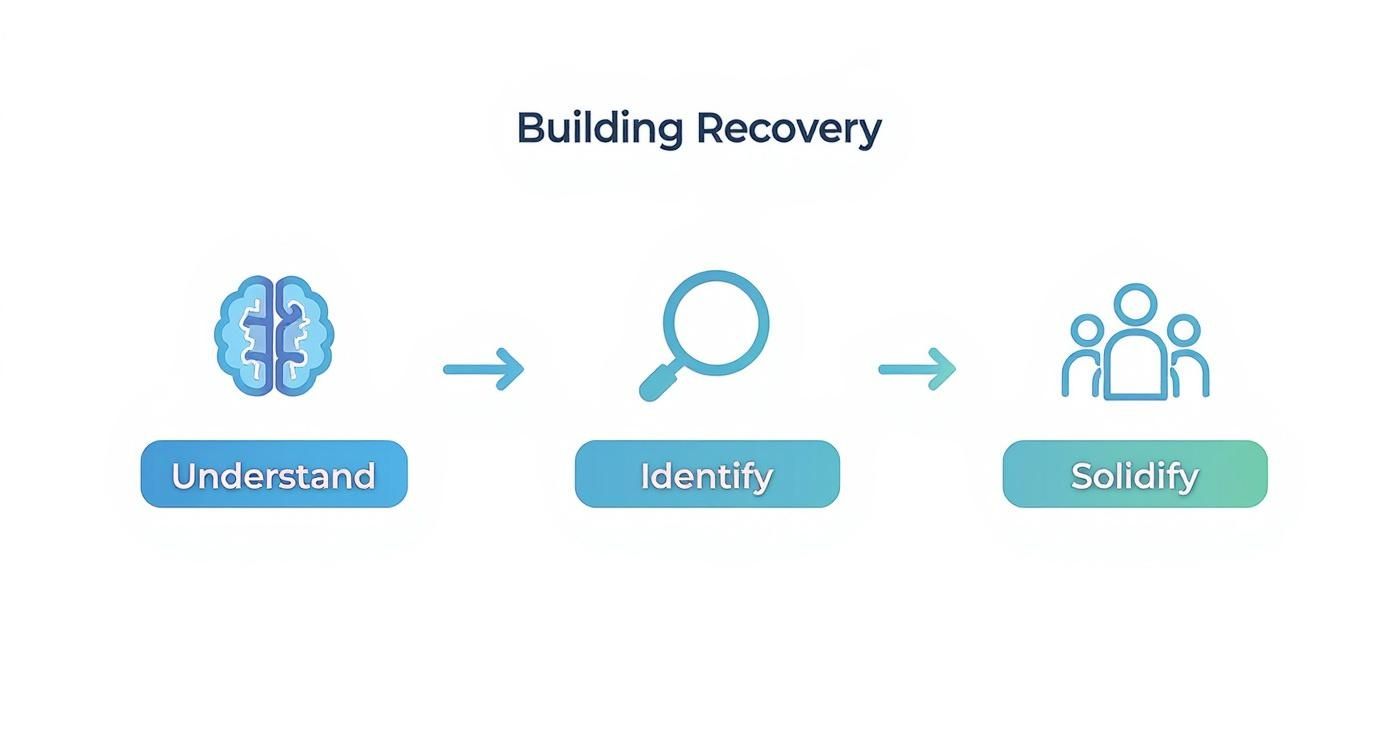
As you can see, the process moves from internal awareness to external action, creating a full safety net. Now, let’s break down exactly how to apply this to your template, step by step.
To keep things clear, here’s a quick summary of the essential sections you’ll be filling out in your plan. Each one serves a distinct purpose in building your defense against relapse.
Key Components of Your Relapse Prevention Plan
| Plan Section | Purpose | Example Entry |
|---|---|---|
| Triggers | To identify the specific people, places, feelings, or situations that create an urge to use. | Internal: Feeling bored and lonely on a Friday night. External: Driving past my old bar after a stressful day at work. |
| Coping Strategies | To list concrete, actionable steps you can take the moment a trigger appears. | "If I feel anxious, I will do a 10-minute guided breathing exercise on my phone." |
| Support Network | To detail who to call, when to call them, and for what specific type of support. | Sponsor: Call immediately for intense cravings. Best Friend: Call for a healthy distraction when I feel lonely. |
| Emergency Plan | A simple, step-by-step list of actions for when you are at immediate risk of relapse. | "1. Remove myself from the situation. 2. Call my sponsor. 3. Read my 'reasons to stay sober' list." |
Having a plan that’s this detailed removes the guesswork when you're under pressure. You’re not trying to invent a solution in a moment of crisis; you're just following the instructions you already wrote for yourself.
Get Specific About Your Triggers
First things first, you need to take a thorough inventory of your personal triggers. These are the unique people, places, feelings, or situations that flip the "use" switch in your brain. It helps to break them down into two distinct categories.
External Triggers are the tangible things in your environment. You can see, hear, or physically experience them. Getting specific is the key to creating strategies to either avoid or manage them.
- Driving past a particular bar or neighborhood.
- Seeing alcohol ads on TV or social media.
- Getting a text from a certain friend from your past.
- Facing a high-pressure deadline at work.
Internal Triggers are your own thoughts, feelings, and physical sensations. These can be trickier because you can't just walk away from them. They’re inside you.
- Feelings of loneliness, boredom, or sadness.
- Anxiety about an upcoming social event.
- Physical pain or sheer exhaustion.
- Thoughts of resentment or feeling sorry for yourself.
Your goal should be to list at least 5-10 specific triggers in each category. Don't just write "stress." Get granular. Is it "the argument I always have with my brother about money" or "the anxiety I feel before a big presentation"? That level of detail makes your plan truly actionable.
Brainstorm Actionable Coping Strategies
Once you know your triggers, you need a list of concrete, healthy things you can do the moment one pops up. "Just relax" isn't a strategy. "Do a 10-minute guided breathing exercise on the Calm app" is. Your plan needs real actions you can execute immediately.
Think about activities that engage your mind, your body, and your spirit. You want a diverse toolkit so you can grab the right tool for the job.
- Mindful Distractions: Anything that requires focus, like tackling a sudoku puzzle, playing guitar, or losing yourself in a good book.
- Physical Outlets: Go for a brisk walk or run, hit the gym for 30 minutes, or do some intense stretching to burn off that nervous energy.
- Creative Expression: Journaling, sketching, painting, or even just putting on a specific playlist that you know can shift your mood.
- Soothing Activities: Taking a hot bath with Epsom salts, brewing a cup of herbal tea, or listening to a guided meditation.
Detail Your Support Network
Your support network is your first line of defense, but a simple list of names won't cut it. Your plan needs to specify who you will call and for what purpose. Assigning roles beforehand removes all the guesswork when you're feeling overwhelmed and vulnerable.
Think about creating a clear chart in your plan:
- Sarah (Sponsor): For immediate crisis support. Call her when a craving is intense or I feel I'm close to using.
- Dr. Evans (Therapist): For emotional processing. Call to schedule a session when underlying issues or old feelings are bubbling up.
- Mike (Best Friend): For healthy distraction. Text him when I’m feeling lonely or bored and just need a safe social outlet.
- Mom: For unconditional encouragement. Call her when I just need a reminder of how far I've come.
This clarity is a gift, especially for family members who want to help but often don't know how. The dynamics of recovery can be tough on relationships, and giving loved ones specific guidance is key. Resources on topics like dealing with an alcoholic spouse can offer them valuable perspective, helping build a home environment that truly supports your journey.
Build a Clear Emergency Action Plan
Finally, you need an emergency action plan. This is your "break glass in case of emergency" guide for those high-stakes moments when your usual coping skills aren't cutting it and you're at immediate risk of relapse.
This section should be a dead-simple, step-by-step list. No room for interpretation.
- Stop everything. Pause for at least five minutes before making any move. If I can, I will physically remove myself from the situation.
- Call my sponsor. I will contact my primary support person immediately and be 100% honest about what’s happening.
- Read my "Reasons to Stay Sober" list. I will pull out the list of motivations I've written in my plan to reconnect with my deeper goals.
- Use a high-intensity coping skill. Go for a hard run or take a cold shower to physically disrupt the craving cycle.
- Go to a safe place. Drive to a support group meeting or a trusted friend's house. I will not stay isolated.
Once you’ve gone through these steps, you won't just have a filled-out template. You'll have a practical, empowering tool that reflects your unique journey, your strengths, and your vision for the future—a true playbook for lasting recovery.
A Real-World Example of a Completed Plan
Theory is great, but seeing a filled-out relapse prevention plan template makes the whole process click. To bring these ideas to life, let’s walk through a realistic example. Meet Maria, a 34-year-old woman in recovery from an opioid use disorder that started with a pain prescription after a car accident.
Maria has finished her initial treatment program and is now creating a solid plan to guide her long-term sobriety. Her personalized entries show exactly how to turn abstract concepts into concrete, life-saving actions. This isn't just a worksheet; it's her personal roadmap for navigating daily life.

Identifying Maria's Unique Triggers
The bedrock of Maria’s plan is an honest list of her specific triggers. She thoughtfully sorts them into internal and external categories, which helps her prepare for both environmental cues and emotional storms. This kind of detail is what makes a plan truly effective.
Maria’s External Triggers:
- Driving past the pharmacy where she used to fill her prescriptions.
- Seeing TV commercials for pain relief medication.
- Receiving unexpected medical bills that cause financial stress.
- Getting a text message from a friend who is still actively using.
Maria’s Internal Triggers:
- A flare-up of chronic back pain from her old injury.
- Feelings of intense loneliness, especially on weekends.
- Anxiety and irritability when feeling overwhelmed at her job.
- The thought that "just one" would be okay to manage her pain.
By writing these down, Maria strips them of their power. They are no longer vague threats lurking in the shadows but known challenges she can actively prepare for.
Outlining Her Coping Strategies
Next, Maria pairs each trigger with a specific, actionable coping skill. She avoids vague goals like "be positive" and instead lists concrete actions she can take in the heat of the moment. Her list is diverse, giving her options depending on the situation and her energy level.
Here are a few of her go-to strategies:
- For Pain Flare-Ups: "I will use my TENS unit for 20 minutes, do my gentle physical therapy stretches, and then listen to a guided meditation for pain management on my Insight Timer app."
- For Loneliness: "I will call my sister, Sarah, just to chat. If she's not available, I'll text my friend from my support group and ask how their day is going."
- For Anxiety: "I will step away from my desk, go for a 15-minute walk outside, and listen to an upbeat playlist I've created called 'My Recovery Mix'."
Maria also makes a point to include techniques from therapy. For instance, she practices a CBT exercise to challenge the automatic thought that she "needs" a pill for her pain. Weaving clinical skills into a daily plan like this is a game-changer.
Structuring Her Support Network
Maria details her support system with crystal-clear roles, removing any guesswork for herself and her loved ones. This section is basically her communication playbook for when she needs help.
- Sponsor (David): First call for intense cravings or if she feels she is at immediate risk. His role is direct, recovery-focused support.
- Therapist (Dr. Chen): Contact for processing underlying emotions or when a trigger is connected to past trauma.
- Sister (Sarah): Call for a reality check, encouragement, or a healthy distraction when feeling lonely or down.
- Boyfriend (Leo): Ask for help with practical things, like going to a movie or cooking dinner together, to change her environment.
This structure ensures she calls the right person for the right reason, making her support network much more effective. Her plan also accounts for medical support—she has a note to discuss new pain management strategies with her doctor. For many in her shoes, understanding what medication-assisted treatment involves is a critical piece of a comprehensive recovery plan.
Maria’s Emergency Action Steps
Finally, Maria creates a simple, numbered list for those high-risk, high-stress moments. This is her "break glass in case of emergency" protocol, designed to be followed without a second thought when her judgment is clouded.
- STOP: Pause immediately. Do not make any decisions for at least 10 minutes.
- LEAVE: Physically remove myself from the person, place, or situation.
- CALL: Contact my sponsor, David, and be completely honest about what’s happening.
- READ: Open my wallet and read the list of my top three reasons for staying sober that I keep on a small card.
- ACT: Go to a pre-planned safe place, like the local coffee shop near my support meeting location, until I feel grounded again.
Maria’s completed plan is more than just a document. It's a living tool, a reflection of her self-awareness and commitment to her own well-being, giving her a clear path forward no matter what challenges pop up.
Weaving Mental Health Into Your Recovery Plan
Recovery from substance use is rarely a single-track journey. More often than not, it’s deeply tangled up with mental health—a reality we call co-occurring disorders or dual diagnosis. Trying to build a recovery plan that ignores your mental health is like trying to patch a leaky boat but only fixing half the holes. It just won't hold up under pressure.
For your relapse prevention plan template to actually work in the real world, it has to account for your whole self, mind and body. A wave of depression can quietly kill your motivation to use healthy coping skills, making old, destructive habits seem like the easier path. In the same way, a sudden spike in anxiety can trigger a powerful, immediate urge to self-medicate.
This isn't a sign of weakness; it's just how interconnected these conditions are. When you address them together in one unified plan, you create a much stronger, more resilient defense against relapse.
Linking Mental Health Symptoms to Substance Use Triggers
The first move is to draw clear, honest lines between your mental health symptoms and your substance use triggers. This takes a bit of detective work into your own emotional patterns. Think of it this way: when you feel a certain way, what happens next?
Get specific with the scenarios:
- Depression: When that familiar feeling of hopelessness and exhaustion creeps in, do you find yourself pulling away from others? For many, this isolation becomes a powerful trigger, making substances feel like a quick way to numb the emptiness.
- Anxiety: If a panic attack hits, is your first instinct to reach for something—anything—to calm your racing heart and thoughts? This reflex forges a direct link between the physical sensations of panic and substance use as a supposed solution.
- Trauma Responses: Do flashbacks or nightmares leave you feeling completely rattled and unsafe? Using substances might have become a way to dissociate from those terrifying feelings and regain a sense of control, even if it's fleeting.
Once you identify these cause-and-effect chains, you can build specific strategies right into your plan to interrupt the cycle before it even gathers steam.
Adding Mental Health Tools to Your Coping Skills List
Your list of coping skills can't just be about managing cravings. It needs to be a go-to toolkit for managing your mental health, too. This means weaving therapeutic techniques and wellness practices directly into your daily relapse prevention plan.
Consider adding a dedicated "Mental Wellness" section with actionable steps like these:
- Grounding Techniques: If anxiety is a major trigger, list 3-5 specific grounding exercises you can do anywhere. For instance: "Name 5 things I can see, 4 things I can touch, 3 things I can hear, 2 things I can smell, and 1 thing I can taste."
- Medication Reminders: Be direct. "Take prescribed medication at 8 AM and 8 PM daily. Set a recurring alarm on my phone."
- Therapy Appointments: Treat them as non-negotiable. "Attend therapy with Dr. Smith every Tuesday at 4 PM. Use the session to discuss this week's challenges."
Integrating these elements transforms your plan from a simple anti-relapse document into a comprehensive guide for your overall well-being. It acknowledges that staying sober is directly tied to staying mentally healthy.
Techniques you pick up in therapy are especially powerful here. One of the most effective approaches, Cognitive Behavioral Therapy, is designed to help you challenge and reframe the negative thought patterns that fuel both addiction and mental health struggles. To add another layer of support for your emotional well-being, you might also want to explore the benefits of art therapy for mental health.
Aligning Your Support Network
Finally, your support network needs to be in the loop on both your recovery and your mental health needs. When you list your emergency contacts, get specific about how each person can help with each aspect of your well-being.
For example, your contact list might look something like this:
- Therapist: Call when a mental health symptom feels overwhelming or to process difficult emotions before they escalate.
- Sponsor: Call for immediate, in-the-moment support when a craving hits hard.
- Trusted Friend: Text when the weight of depression feels heavy and you just need a positive social connection without any pressure.
This level of detail empowers your support system. It gives them a clear playbook so they can provide the right kind of help at the right time. It creates a coordinated safety net that addresses every part of who you are, making sure that no single challenge can derail your progress toward a healthy, stable, and sober life.
Keeping Your Relapse Prevention Plan Alive

Creating your relapse prevention plan is a huge first step. But its real power comes from using it as a living, breathing guide—not a piece of paper that gathers dust in a drawer. For the plan to work, it has to become an active part of your recovery, evolving as you grow and face new curveballs.
Think of it less like a static map and more like a real-time GPS for your sobriety. It needs regular updates to reflect where you are now, the new roadblocks you’ve encountered, and the smarter routes you’ve discovered along the way. Your plan should be a trusted companion on this journey, not a forgotten relic.
Making Your Plan a Habit
The key is weaving your plan into your daily and weekly routine. You want reviewing it to feel as natural as other healthy habits, like exercise or meditation. This means scheduling time for it, especially in early recovery when you're still building a solid foundation.
Here are a few practical ways to keep your plan front and center:
- Set a Weekly Review: Block out 15-20 minutes on your calendar—say, every Sunday evening—to read through the entire plan. This keeps the big picture fresh.
- Bring It to Therapy: Make it a habit to bring your plan to every session with your therapist here at Altura Recovery. Talk about what’s working, what isn’t, and how recent events might call for an update.
- Do a Daily Check-In: Start your morning by reviewing just one key section, like your coping strategies or your list of reasons for staying sober. It’s a powerful way to ground yourself for the day ahead.
This consistent engagement is what transforms the document from a simple set of rules into a genuine source of personal strength and clarity.
Your relapse prevention plan isn't a "set it and forget it" tool. It's a commitment to ongoing self-awareness. Active use is what makes it a powerful shield against complacency.
The transition from a structured treatment setting back into the rhythm of daily life is an especially vulnerable time. Research shows that roughly 50% of patients relapse within the first 12 weeks after leaving an intensive inpatient program. This stark number highlights why a dynamic, consistently used plan isn't just a nice idea—it's critical for navigating those crucial early months. You can dig deeper into post-treatment outcomes by exploring the full research on recovery statistics.
When and How to Update Your Plan
Your plan needs to grow with you. It should be a running record of your wins and a reflection of your hard-earned wisdom. Certain moments are perfect opportunities for a refresh.
Update your plan right after you successfully navigate a high-risk situation. Did you face an unexpected trigger and try a new coping skill that worked like a charm? Add it to your list immediately. This not only reinforces your success but also adds a proven tool to your arsenal for the next time.
Likewise, major life changes are a clear signal to revise your plan. Starting a new job, moving to a new city, or even beginning a new relationship can introduce unforeseen triggers and stressors. Adjusting your plan proactively helps you prepare for these new dynamics, ensuring it stays relevant and effective. Your recovery journey is always in motion, and your plan must be, too.
Answering Your Questions About Relapse Prevention Plans
Even with a detailed guide and a template ready to go, real-world questions always pop up. That’s a good sign—it means you’re already thinking about how to put this powerful tool into action. Let’s walk through some of the most common questions we hear at Altura to give you that extra bit of clarity and confidence.
How Often Should I Update My Plan?
Think of your plan as a living, breathing document, not something you write once and file away. In the early days of recovery, making a weekly review part of your routine is a fantastic habit. It keeps your strategies fresh and top-of-mind.
As you build confidence and your sobriety feels more solid, shifting to a monthly check-in usually works just fine.
The most critical times to update, though, are after big life changes. A new job, a move, a breakup—these events can bring a whole new set of stressors and triggers you hadn't planned for. On the flip side, every time you successfully navigate a tough craving or a high-risk situation, update your plan! Add the new coping skill that worked. This keeps your plan relevant, sharp, and genuinely useful.
Who Should I Share My Prevention Plan With?
You absolutely don’t need to show this to everyone. The goal is to share it with a small, trusted circle of people who are actively and positively involved in your recovery. These are your go-to allies.
Your core support system should probably include:
- Your therapist or counselor here at Altura Recovery, who can help you spot blind spots and refine your strategies.
- Your sponsor, who can offer that in-the-moment guidance based on what you’ve already laid out.
- A trusted partner or family member, especially someone who lives with you or sees you often.
Sharing your plan gives these key people a clear playbook. It removes the guesswork and empowers them to give you the exact support you need when you need it most, whether that’s a reminder of a coping skill or a crisis contact.
What Is the Difference Between a Trigger and a Craving?
This is a fantastic question because people often use these words interchangeably, but they mean very different things. Nailing down the distinction is a game-changer for using your plan effectively.
A trigger is the spark. It’s the specific person, place, feeling, or memory that first plants the thought of using in your mind. A trigger can be external, like driving past your old bar, or internal, like a sudden wave of anxiety washing over you.
A craving is the intense psychological and physical urge to use that follows the trigger. It’s that powerful, full-body pull you feel in response to the initial spark. Your plan is designed to help you spot and manage triggers before they explode into overwhelming, hard-to-resist cravings.
Think of it like this: A trigger is seeing the lightning flash in the distance. A craving is hearing the thunder roll in and feeling the storm right on top of you. Your plan is your shelter.
What If I Relapse Even With a Plan?
First, take a deep breath. A relapse is not a moral failure or a sign that you can’t do this. It’s a sign that the plan needs an adjustment. It’s data—painful, yes, but incredibly valuable.
If a slip happens, your plan becomes more important than ever. Your first move is to activate your emergency action steps immediately. This is about ensuring your safety and getting you reconnected with your support team right away.
Afterward, the most crucial step is to sit down with your therapist and honestly review the plan. What happened? Was there a trigger you hadn't identified? Was a coping strategy not as effective as you thought it would be? Use this new information to make your plan even stronger. A relapse doesn’t erase your progress; it becomes part of your recovery story and can lead to an even more resilient sobriety.
At Altura Recovery, we see a relapse prevention plan as a cornerstone of lasting sobriety. Our outpatient programs are designed to help you build, practice, and refine your plan with expert guidance, ensuring you have the tools you need to navigate life's challenges with confidence. Learn more about our supportive outpatient care in Houston.

